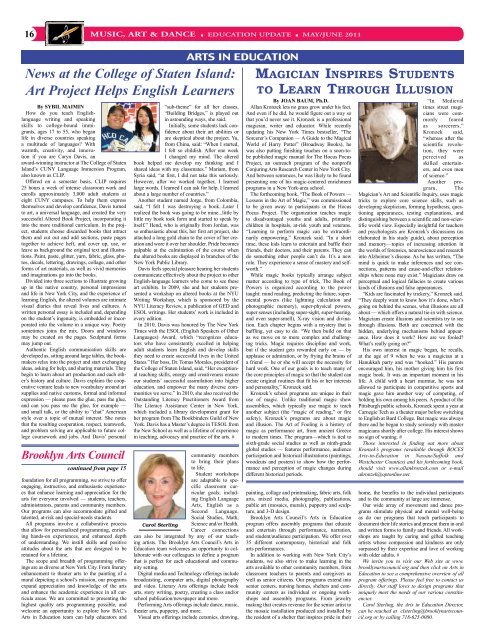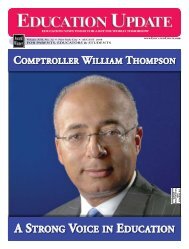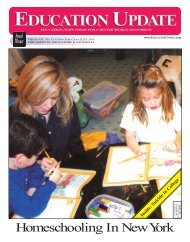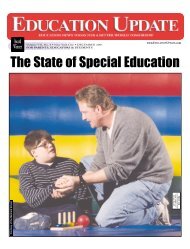You also want an ePaper? Increase the reach of your titles
YUMPU automatically turns print PDFs into web optimized ePapers that Google loves.
16 Music, art & Dance ■ EDUCATION UPDATE ■ MAY/JUNE 2011News at the College of Staten Island:Art Project Helps English LearnersBy Sybil MaiminHow do you teach Englishlanguagewriting and speakingskills to college-bound immigrants,ages 17 to 55, who beganlife in diverse countries speakinga multitude of languages? Withwarmth, creativity, and innovationif you are Caryn Davis, anaward-winning instructor at The College of StatenIsland’s CUNY Language Immersion Program,also known as CLIP.Offered on a semester basis, CLIP requires25 hours a week of intense classroom work andenrolls approximately 3,000 adult students ateight CUNY campuses. To help them expressthemselves and develop confidence, Davis turnedto art, a universal language, and created the verysuccessful Altered Book Project, incorporating itinto the more traditional curriculum. In the project,students choose discarded books that attractthem and cut out and add sections, paste pagestogether to achieve heft, and cover up, use, orleave as background the original text and illustrations.Paint, paste, glitter, yarn, fabric, glass, photos,decals, lettering, drawings, collage, and otherforms of art materials, as well as vivid memoriesand imaginations go into the books.Divided into three sections to illustrate growingup in the native country, personal impressionsand life in New York City, and the experience oflearning English, the altered volumes are intimatevisual diaries that reveal lives and cultures. Awritten personal essay is included and, dependingon the student’s ingenuity, is embedded or incorporatedinto the volume in a unique way. Poetrysometimes joins the mix. Doors and windowsmay be created on the pages. Sculptural formsmay jump out.Authentic English communication skills aredeveloped as, sitting around large tables, the bookmakersrelax into the project and start exchangingideas, asking for help, and sharing materials. Theybegin to learn about art production and each other’shistory and culture. Davis explains the cooperativeventure leads to new vocabulary around artsupplies and native customs, formal and informalexpression — please pass the glue, pass the glue,and can you pass me the glue, for example —and small talk, or the ability to “chat” Americanstyle over a topic of mutual interest. She notesthat the resulting cooperation, respect, teamwork,and problem solving are applicable to future collegecoursework and jobs. And Davis’ personalBrooklyn Arts Councilcontinued from page 15foundation for all programming, we strive to offerengaging, instructive, and enthusiastic experiencesthat enhance learning and appreciation for thearts for everyone involved — students, teachers,administrators, parents and community members.Our programs can also accommodate gifted andtalented, at-risk and special-needs students.All programs involve a collaborative processthat allow for personalized programming, enrichinghands-on experiences, and enhanced depthof understanding. We instill skills and positiveattitudes about the arts that are designed to beretained for a lifetime.The scope and breadth of programming offeringsare as diverse at New York City. From literaryenhancement to theater arts to the painting of amural depicting a school’s mission, our programsexpand appreciation and knowledge of the artsand enhance the academic experience in all curriculaareas. We are committed to presenting thehighest quality arts programming possible, andwelcome an opportunity to explore how BAC’sArts in <strong>Education</strong> team can help educators and“sub-theme” for all her classes,“Building Bridges,” is played outin astounding ways, she said.Initially, some students lack confidenceabout their art abilities orare skeptical about the project. Yu,from China, said: “When I started,I felt so childish. After one weekI changed my mind. The alteredbook helped me develop my thinking and Ishared ideas with my classmates.” Mariam, fromSyria said, “at first, I did not take this seriously.However, after we worked together, I learnedlarge words. I learned I can ask for help. I learnedabout a large number of countries.”Another student named Jorge, from Colombia,said, “I felt I was destroying a book...Later Irealized the book was going to be mine...little bylittle my book took form and started to speak byitself.” Hend, who is originally from Jordan, wasso enthusiastic about this, her first art project, sheattached a long gold chain to the cover of her creationand wore it over her shoulder. Pride becomespalpable at the culmination of the course whenthe altered books are displayed in branches of theNew York Public Library.Davis feels special pleasure hearing her studentscommunicate effectively about the project to otherEnglish-language learners who come to see theseart exhibits. In 2009, she and her students presenteda workshop on altered books at the NYUWriting Workshop, which is sponsored by theNYU Literacy Review, a publication of GED andESOL writings. Her students’ work is included inevery edition.In 2010, Davis was honored by The New YorkTimes with the ESOL (English Speakers of OtherLanguages) Award, which “recognizes educatorswho have consistently excelled in helpingadult students learn English and develop skillsthey need to create successful lives in the UnitedStates.” Her boss, Dr. Tomas Morales, president ofthe College of Staten Island, said, “Her exceptionalteaching skills, energy and creativeness ensureour students’ successful assimilation into highereducation, and empower the many diverse communitieswe serve.” In 2010, she also received theOutstanding Literacy Practitioners Award fromThe Literacy Assistance Center in New York,which included a library development grant forher program from The Bookbinders Guild of NewYork. Davis has a Master’s degree in TESOL fromthe New School as well as a lifetime of experiencein teaching, advocacy and practice of the arts. #ARTS IN EDUCATIONcommunity membersto bring their plansto life.Student workshopsare adaptable to specificclassroom curriculargoals; includingEnglish LanguageArts, English as aSecond Language,Social Studies, Math,Carol Sterling Science and/or Health.Career connectionscan also be integrated by any of our teachingartists. The Brooklyn Arts Council’s Arts in<strong>Education</strong> team welcomes an opportunity to collaboratewith our colleagues to define a programthat is perfect for each educational and communitysetting.Digital media and Technology offerings includebroadcasting, computer arts, digital photographyand video. Literary Arts offerings include bookarts, story writing, poetry, creating a class and/orschool publication/newspaper and more.Performing Arts offerings include dance, music,theater arts, puppetry, and more.Visual arts offerings include ceramics, drawing,Magician Inspires Studentsto Learn Through IllusionBy Joan Baum, Ph.D.Allan Kronzek lets no grass grow under his feet.And even if he did, he would figure out a way sothat you’d never see it. Kronzek is a professionalmagician, writer and educator. While recentlyupdating his New York Times bestseller, “TheSorcerer’s Companion — A Guide to the MagicalWorld of Harry Potter” (Broadway Books), hewas also putting finishing touches on a soon-tobepublished magic manual for The Hocus PocusProject, an outreach program of the nonprofitConjuring Arts Research Center in New York City.And between sentences, he was likely to be foundpresenting one of his magic-centered enrichmentprograms in a New York-area school.The forthcoming book, “The Book of Powers —Lessons in the Art of Magic,” was commissionedto be given away to participants in the HocusPocus Project. The organization teaches magicto disadvantaged youths and adults, primarilychildren in hospitals, at-risk youth and veterans.“Learning to perform magic can be extraordinarilyempowering,” Kronzek said. “In a shorttime, these kids learn to entertain and baffle theirfriends, their doctors, and their parents. They cando something other people can’t do. It’s a newrole. They experience a sense of mastery and selfworth.”While magic books typically arrange subjectmatter according to type of trick, The Book ofPowers is organized according to the powertaught: mind reading, predicting the future, supermentalpowers (like lightning calculation andphotographic memory), super-physical powers,super senses (including super-sight, super-hearing,and even super-smell), X-ray vision and divination.Each chapter begins with a mystery that isbaffling, yet easy to do. “We then build on thatas we move on to more complex and challengingtricks. Magic requires discipline and work,but if the student gets rewarded early on — byapplause or admiration, or by frying the brains ofa friend — he or she will accept the necessity forhard work. One of our goals is to teach many ofthe core principles of magic so that the student cancreate original routines that fit his or her interestsand personality,” Kronzek said.Kronzek’s school programs are unique in theiruse of magic. Unlike traditional magic showassemblies, which typically use magic to teachanother subject (the “magic of reading,” or firesafety), Kronzek’s programs are about magicand illusion. The Art of Fooling is a history ofmagic as performance art, from ancient Greeceto modern times. The program—which is tied tosixth-grade social studies as well as ninth-gradeglobal studies — features performance, audienceparticipation and historical illustrations (paintings,woodcuts and posters) to show how the performanceand perception of magic changes duringdifferent historical periods.painting, collage and printmaking, fabric arts, folkarts, mixed media, photography, publications,public art (mosaics, murals), puppetry and sculpture,and 3-D design.Brooklyn Arts Council’s Arts in <strong>Education</strong>program offers assembly programs that educateand entertain through performance, narration,and student/audience participation. We offer over35 different contemporary, historical and folkarts performances.In addition to working with New York City’sstudents, we also strive to make learning in thearts available to other community members, fromclassroom teachers to parents and caregivers aswell as senior citizens. Our programs extend intosenior centers, nursing homes, shelters and communitycenters as individual or ongoing workshopsand assembly programs. From jewelrymaking that creates revenue for the senior artist tothe mosaic installation produced and installed bythe resident of a shelter that inspires pride in their“In Medievaltimes street magicianswere commonlyfearedas sorcerers,”Kronzek said,“whereas after thescientific revolution,they wereperceived asskilled entertainers,and even menof science.”Another program,TheMagician’s Art and Scientific Inquiry, uses magictricks to explore core science skills, such asdeveloping skepticism, forming hypothesis, questioningappearances, testing explanations, anddistinguishing between a scientific and non-scientificworld view. Especially insightful for teachersand psychologists are Kronzek’s discussions (aselaborated in his study guide), about perceptionand memory—topics of increasing attention inthe worlds of forensics, neuroscience and researchinto Alzheimer’s disease. As he has written, “Themind is quick to make inferences and see connections,patterns and cause-and-effect relationshipswhere none may exist.” Magicians draw onperceptual and logical fallacies to create variouskinds of illusions and false appearances.“Kids are fascinated by trickery,” Kronzek said.“They deeply want to know how it’s done, what’sgoing on behind the scenes, what illusions are allabout — which offers a natural tie-in with science.Magicians create illusions and scientists try to seethrough illusions. Both are concerned with thehidden, underlying mechanisms behind appearance.How does it work? How are we fooled?What’s really going on?”His own interest in magic began, he recalls,at the age of 9 when he was a magician at aHanukkah party and was “hooked.” His parentsencouraged him, his mother giving him his firstmagic book. It was an important moment in hislife. A child with a heart murmur, he was notallowed to participate in competitive sports andmagic gave him another way of competing, ofholding his own among his peers. A product of thePittsburgh public schools, Kronzek spent a year atCarnegie Tech as a theater major before switchingto English at Bard College. But magic was alwaysthere and he began to study seriously with mastermagicians shortly after college. His interest showsno sign of waning. #Those interested in finding out more aboutKronzek’s programs (available through BOCESArts-in-<strong>Education</strong> in Nassau/Suffolk andWestchester Counties) and his forthcoming book,should visit www.allankronzek.com or e-mailakronzek@optonline.net.home, the benefits to the individual participantsand to the community at large are immense.Our wide array of movement and dance programsstimulate physical and mental well-beingas do our programs that teach participants todocument their life stories and present them in oraland written forms to family and friends. All workshopsare taught by caring and gifted teachingartists whose compassion and kindness are onlysurpassed by their expertise and love of workingwith older adults. #We invite you to visit our Web site at www.brooklynartscouncil.org and then click on Arts in<strong>Education</strong> to see a comprehensive overview of allprogram offerings. Please feel free to contact usdirectly. Our staff loves to design programs thatuniquely meet the needs of our various constituencies.Carol Sterling, the Arts in <strong>Education</strong> Director,can be reached at clsterling@brooklynartscouncil.orgor by calling 718-625-0080.
















